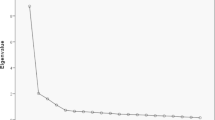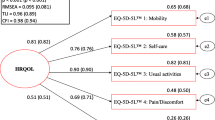Abstract
Objective
The Chinese Quality of Life Instrument (ChQOL) was developed as a valid generic health status instrument based on the well-established theory of health in Chinese medicine. Psychometric properties of the ChQOL were good. In the present study, the responsiveness of the ChQOL in patients with congestive heart failure (CHF) were investigated and compared with two generic questionnaires, the Medical Outcomes Study Short Form 36-item Health Survey (SF-36) and World Health Organization Quality of Life Assessment (WHOQOL-BREF), as well as one disease-specific questionnaire, the Minnesota Living with Heart Failure Questionnaire (MLHF).
Methods
Thirty-nine in-patients with CHF who had undergone treatment with integrative medicine were recruited. The health status measurements were performed at enrolment and after a 4-week treatment. The following responsiveness indices were used: the effect size (ES) and standardized response mean (SRM). All patients were classified into those groups with stable measures and those groups with changes after a 4-week treatment, based upon both the doctor’s global rating of changes in heart function tests, and the patient’s global rating of changes in overall quality of life.
Results
All domains of the ChQOL showed significant improvement. In the comparison of the responsiveness indices, the ChQOL was regarded as more responsive than the WHOQOL-BREF or SF-36 utility, but it was less responsive than the MLHF.
Conclusions
The ChQOL was better in sensitivity and responsiveness for assessing congestive heart failure as a generic measure than the SF-36 and WHOQOL-BREF. The ChQOL is considered suitable as an outcome measure for clinical trials in patients with congestive heart failure.
Similar content being viewed by others
References
Leung KF, Liu FB, Zhao L, et al. Development and validation of the Chinese Quality of Life Instrument. Health and Quality of Life Outcome 2005; 3: 26. http://www.hqlo.com/content/3/1/26.
Zhao L, Liu FB, Leung KF, et al. Reliability and validity of the Chinese Quality of Life Instrument. Chin J Clin Rehabil (Chin) 2006;10(8):1–3.
Deyo RA, Diehr P, Patrick D. Reproducibility and responsiveness of health status measures. Control Clin Trials 1991; 2: 142S–158S.
Oga T, Nishimura K, Tsukino M, et al. A comparison of the responsiveness of different generic health status measures in patients with asthma. Quality Life Res 2003;12: 555–563.
Kleber FX, Niemoller L, Doering W. Impact of converting enzyme inhibition on progression of chronic heart failure: results of the Munich mild heart failure trial. Br Heart J 1992;67:289–296.
Ware JE, Sherbourne CD. The MOS 36-item short form health survey (SF-36): I. Conceptual framework and item selection. Med Care 1992;30:473–483.
McHorney CA, Ware JE, Raczek AE. The MOS 36-item short-form health survey (SF-36): II. Psychometric and clinical tests of validity in measuring physical and mental health constructs. Med Care 1993;31:247–263.
The WHOQOL Group. Study protocol for the World Health Organization project to develop a quality of life instrument (WHOQOL). Quality Life Res 1993;2(2):153–159.
The WHOQOL Group. The World Health Organization Quality of Life Assessment (WHOQOL): development and general psychometric properties. Social Sci Med 1998;46:1569–1585.
The WHOQOL Group. Development of the World Health Organization WHOQOL-BREF Quality of Life Assessment. Psychol Med 1998;28: 551–558.
Rector TS, Kubo SH, Cohn JN. Patients’ self-assessment of their congestive heart failure. Part 2: content, reliability and validity of a new measure, The Minnesota Living with Heart Failure Questionnaire. Heart Failure 1987;3:198–209.
Middel B, Bouma J, de Jongste M, et al. Psychometric properties of the Minnesota Living with Heart Failure Questionnaire (MLHF-Q). Clin Rehabil 2001;15(5):489–500.
Braunwald E, ed. Translated by Chen HZ. Cardiology. 5th ed. Beijing: People’s Medical Publishing House, 2000:413–414.
Hao YT, Fang JQ. The introduce and usage of WHOQOL instrument in Chinese. Modern Rehabil (Chin) 2000;4(8):1127–1129, 1145.
Hao YT, Fang JQ, Li CX, et al. The World Health Organization Quality of Life Assessment (WHOQOL) Chinese version. Foreign Med Sci (Section of Social Medicine, Chin) 1999;16(3):118–122.
Fang JQ, ed. Quality of life assessment and application. Beijing: Beijing Medical University Press, 2000:113–143.
Deyo RA. Comparative validity of the sickness impact profile and shorter-scales for functional assessment in low-back pain. Spine 1986;11:951–954.
Kazis LE, Anderson JJ, Meenan RF. Effect sizes for interpreting changes in health status. Med Care 1989;27(3 Suppl): S178–S189.
Cohen J. Statistical power analysis for the behavioural sciences. 2nd ed. New Jersey: Lawrence Erlbaum Associates, 1988:531–535.
Jaglal S, Lakhani Z, Schatzker J. Reliability, validity, and responsiveness of the lower extremity measure for patients with a hip fracture. J Bone Joint Surg Am 2000; 82-A:955–962.
Liang MH, Fossel AH, Larson MG. Comparisons of five health status instruments for orthopedic evaluation. Med Care 1990;28:632–642.
Katz JN, Larson MG, Phillips CB, et al. Comparative measurement sensitivity of short and longer health status instruments. Med Care 1992;30: 917–925.
Bombardier C, Raboud J. A comparison of health-related quality of life measures for rheumatoid arthritis research. Control Clin Trials 1991;12:243S–256S.
Wiklund I, Karlberg J. Evaluation of quality of life in clinical trials: Selecting quality-of-life measures. Control Clin Trials 1991;12(4 Suppl):204S–216S.
Curtis RJ, Deyo RA, Hudson LD. Health-related quality of life among patients with chronic obstructive pulmonary disease. Thorax 1994;49:162–170.
Fayers PM, Machin D. Quality of life-assessment, analysis and interpretation. West Sussex, England: John Wiley & Son, 2000:322–348.
Wright JG, Young NL. A comparison of different indices of responsiveness. J Clin Epidemiol 1997;50:239–246.
Author information
Authors and Affiliations
Corresponding author
Additional information
Supported by the National Natural Science Foundation of China (No. 30371718)
Rights and permissions
About this article
Cite this article
Zhao, L., Leung, Kf., Liu, Fb. et al. Responsiveness of the Chinese Quality of Life Instrument in patients with congestive heart failure. Chin. J. Integr. Med. 14, 173–179 (2008). https://doi.org/10.1007/s11655-008-0173-6
Received:
Published:
Issue Date:
DOI: https://doi.org/10.1007/s11655-008-0173-6




